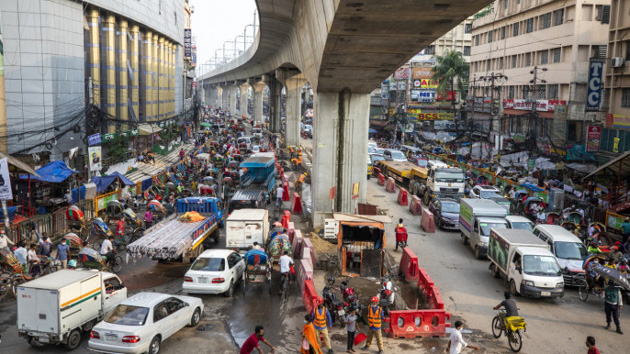Dhaka, Aug 26: Dhaka’s roads, known for its notorious traffic, have become more chaotic as sporadic protests by various organisations have led to severe congestion, leaving commuters stranded and scrambling for alternative routes.
On Monday morning, rickshaw pullers blocked the Shahbagh intersection to demand a ban on battery-operated auto rickshaws and other issues, stopping all traffic on nearby roads.
The protest began around 10:30 a.M.
The rickshaw pullers protesting at Shahbagh claimed that autorickshaw drivers were charging too little—Tk20 (approx Rs 14) instead of the standard Tk50 (approx Rs 35)—from passengers, which meant they weren’t getting any business.
They also pointed out that autorickshaws, which previously operated in the alleys, now run on main roads, ignoring traffic rules and causing traffic jams and accidents.
This situation has worsened the already chaotic traffic and led to a shortage of public transportation options for commuters.
On Sunday, the city’s traffic came to a standstill in key locations including the High Court, Motsho Bhaban, Shahbagh, Science Lab, and Dhanmondi. Protesters took to the streets in these areas to voice their demands, further aggravating the already notorious traffic situation in Dhaka.
Many commuters found themselves abandoning their vehicles and walking to their destinations due to the prolonged congestion.
“I was stuck in traffic for hours. After crossing Shahbagh and reaching the High Court area, my vehicle came to a halt. I had no choice but to get out and continue on foot,” said Rakibul Hasan, a commuter travelling from Dhanmondi to Paltan.
His experience is a testament to the widespread disruptions faced by many in the city.
In 2023, Dhaka was ranked the fifth worst city in the world for traffic congestion in Numbeo’s Traffic Index, up from ninth place in 2022, with the average one-way travel time increasing from 61 minutes to 57.8 minutes.
Adding to the congestion, a programme by the Ansars, a volunteer security force, led to significant traffic jams around Purana Paltan, Bijoy Nagar, Gulistan, and Segunbagicha.
The disruption extended to areas like Banglamotor, Kawran Bazar, and Farmgate, creating a ripple effect throughout Dhaka’s road network.
“The protests are constant and sporadic, making it nearly impossible to predict traffic conditions from one day to the next,” said Ajijul Ahmed, another frustrated commuter.
“It feels like every few hours there’s a new roadblock or demonstration, and it’s causing a lot of inconvenience for people trying to go about their daily lives,” he said.
The Dhaka Metropolitan Police (DMP) has been struggling to manage the traffic chaos.
A senior official of traffic police said various organisations have been holding programmes and sit-ins leading to road blockades and traffic.
“On Sunday there were a lot of processions and also sit-ins by the Ansar group. Demonstrations and protests by several groups and communities in various pockets have been a regular affair for the last few weeks. That has led to a lot of traffic congestion,” a traffic police official said.
With one side of the road closed, traffic pressure has shifted to surrounding areas. Although we have advised using alternative routes, drivers are often disregarding this, resulting in additional congestion.”
The reopening of the metro services, which had been closed due to the violent anti-government protests, has somewhat alleviated the strain on other modes of transportation.
However, the relief has been limited as continuous and sporadic protests continue to disrupt traffic flow.
Commuters who previously relied on the metro are now facing the dual challenge of navigating congested roads and dealing with the unpredictability of protest-related disruptions.
With the metro back in operation, many students and office-goers have returned to using this mode of transport. However, the impact of the prolonged protests is still felt.
The return of metro services has not fully resolved the traffic issues, as the ongoing demonstrations continue to create bottlenecks and delays.
The economic impact of these disruptions has been significant.
The cost of commuting has increased due to higher fares for cabs and auto rickshaws, and the delays have affected business operations and daily routines.
Middle-class families and students, already strained by rising costs, find themselves further burdened by the need to navigate through the traffic chaos.
“There is a problem of inflation in Bangladesh and the ongoing traffic crisis has only aggravated the situation for middle-class people like us who have to depend on public transport. In several places cabs and auto-rickshaws charge us more than the normal rates,” Sukumar Mitra, an employee at a three-star hotel here.
Both Shahbagh and the adjoining Teacher-Student Centre (TSC) area, close to Dhaka University, were central to the protests that led to the ousting of Prime Minister Sheikh Hasina’s government on August 5. Hasina fled to India amid escalating violence and unrest, leaving a volatile situation in her wake.
As Dhaka grapples with the ongoing and sporadic protests, the city’s infrastructure and public services are under severe strain.
Commuters like Sadikul Hasan and Ajijul Ahmed are left to navigate a constantly shifting landscape of roadblocks and delays, hoping for a resolution to the unrest that has so profoundly impacted their daily lives.
The city’s traffic woes, exacerbated by the protests, highlight the broader issues facing Dhaka’s transportation system and the ongoing struggle for stability in the capital.
After unprecedented anti-government protests, which reached a crescendo on August 5, Hasina resigned as prime minister and fled the country. She landed in India on August 5 and is currently staying there. (PTI)
Trending Now
E-Paper


